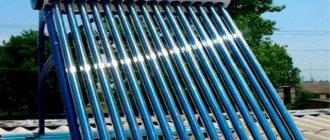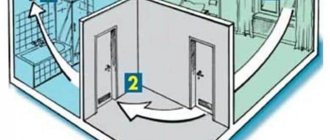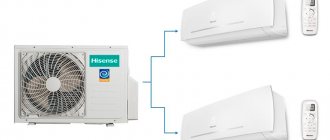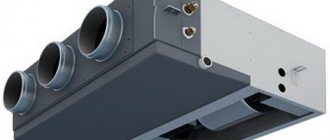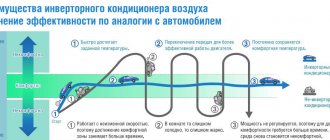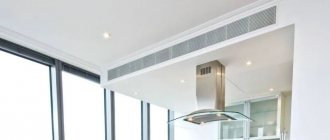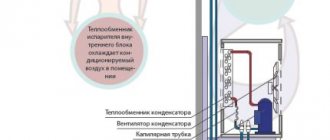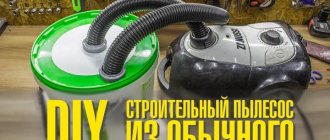What is the difference between a split system and an air conditioner?
There are no differences between these devices - they are the same device. In fact, a split system is one of the types of air conditioners, consisting of one, two or more units.
Single air conditioners include conventional air conditioners that are installed on a window, in cars, or are mobile. The last category includes split systems.
The term itself comes from English and means “split system” or “separate system”, consisting of an external and internal unit.
In a conventional air conditioner (mobile or window), the main parts are located in one housing. This results in high noise levels (up to 50 decibels).
It is extremely difficult to fall asleep while such a device is operating, which is why it was decided to divide it into two sets. The first (noisy) is installed outdoors, and the second (quiet) is installed directly in the room.
Many people believe that the outer part is needed to draw in air. But that's not true. In practice, the air flow intake is taken over by the indoor unit, which is located inside the room and does not cause problems for users in terms of noise.
But there are also models in which air is taken from the outside, then cooled, and then supplied to the room.
In general, there are several differences between a split system and an air conditioner:
- Design. Mobile and window devices are large in size, and indoor units have a stylish appearance and can be mounted in different places.
- Heating. Modern split systems can not only cool, but also heat the air.
- Installation. Separate systems are more difficult to install, but they have more capabilities. Air conditioners are easier to install - you just need to connect them to an outlet, remove the condensate pipe and use it.
Differences between a split system and a conventional air conditioner.
| Design features | Split system | Air conditioner |
| Number of blocks | Two blocks, external and internal | Monoblock |
| Installation Features | The outdoor unit is mounted outside and acts as a condenser (consists of a compressor, fan and condensation system), and the indoor unit is mounted indoors and consists of an evaporator and a fan. | Installed in a specific location, for example, in a car or in a window. All elements are mounted in one housing. |
| Difficulty of installation | Cassette and duct systems are difficult to install. Wall and ceiling ones are easier to install. | Easy to install. |
| Connecting other units | It is possible to connect several internal units to one external unit | — |
Lastly about installation
As a rule, installation work is carried out by refrigeration technicians who have special equipment - a vacuum pump, a pressure gauge manifold and a hammer drill for drilling walls. But low-power models - “sevens”, “nines” - can be mounted independently by renting the listed tool.
Installation recommendations:
- Place the outdoor module under the window for ease of maintenance; place the indoor module closer to the outer wall. It is better to keep within 3 meters.
- Purchase copper tubing that matches the diameter of the service ports located on the side of the case.
- To prevent the unit from vibrating or humming when the compressor is operating, securely fasten it to the wall bracket.
- Carefully flare the copper tubes - the tightness of the system and the performance of the “split” depend on this.
- Do not place the external unit on a glassed-in loggia or balcony.
We also recommend that you carefully read the factory instructions for the air conditioner and familiarize yourself with our installation guide for a home air cooler.
Advantages and disadvantages
Pros:
- automatic maintenance of the set room temperature;
- creating an optimal microclimate;
- quiet operation;
- large range of devices;
- consumption of a relatively small amount of energy;
- convenient control system;
- Possibility of use even at sub-zero temperatures.
Minuses
- higher price compared to simple air conditioners;
- fear of voltage surges (installation of a stabilizer is recommended);
- deterioration of the appearance of the building due to the bulky external unit;
- complexity of maintenance that must be done periodically without fail.
What is the difference between an air conditioner and a split system
Some more interesting facts
Choosing an air conditioner is not an easy task. This is not an item that you can give up on, say “it doesn’t fit, we’ll buy another one,” and with a light heart put the unsuccessful purchase into the far corner.
Both a floor-standing air conditioner and a split system are quite expensive devices designed to serve their owner for quite a long time. That is why it is so important to make the right choice and buy an air conditioner that is best suited for your purposes.
So, which is better: a split system or a floor-standing air conditioner? Let's try to look at the advantages and disadvantages of each of these air cooling devices.
Advantages of floor-standing air conditioners:
- Portability. After all, even the second name of a floor-standing air conditioner sounds like “mobile candy bar.” This device can be installed in almost any convenient place indoors (placement near heating and heating devices is not recommended).
- Simplicity and ease of installation. If you decide to buy a floor standing air conditioner, then you won't have to worry about calling a professional to install it. Installation of such an air conditioner is quite easy and simple: install the monoblock indoors and lead its air duct into the ventilation or outside (through a window or hole in the wall).
- Many models have a timer and remote control, as well as air ionizers and fine filters.
Disadvantages of floor-standing air conditioners:
- Limited power (usually up to 4 kW). However, such devices cope with their functions quite effectively, especially in rooms with a small area (apartments, country houses, offices).
- The noise level of floor-standing air conditioners (compared to stationary devices) is quite high.
- The need to periodically clean the pan from accumulating condensate. If you do not want to carry out this procedure every day, then it is best to buy a floor-standing air conditioner with a capacious condensate collector.
Advantages of split systems:
- Low noise level (less than 30 dB). The noisiest part of the device is mounted on the outside of the building.
- High power (up to 7 kW and more). Thus, split systems can effectively cool or warm the air in rooms with a large area (up to 100 m2).
- Large range of indoor units. You can buy a split system that will best fit into the interior of the room.
- Many types of split systems. For retail facilities, it would be more advisable to buy a cassette split system that sprays cooled air in 4 directions. Huge column air conditioners are usually installed in rooms with a large area (conference rooms, restaurants, etc.). Duct split systems are capable of supplying cooled air to several adjacent rooms at once, and multi-split systems can create a favorable microclimate in rooms located at a considerable distance from each other. You can also opt for floor-ceiling split systems with a power of up to 15 kW or standard wall-mounted air conditioners.
- Many models have ionization and air purification functions.
Disadvantages of split systems:
- Requires professional installation. Installation and maintenance of such devices should only be carried out by specialists.
- Many split systems (not counting cassette systems) cannot create a flow of fresh air into the room.
- The cost of split systems (especially installations with high power) is quite high.
Let's try to summarize
A floor-standing air conditioner is a portable device that does not have much power and is capable of cooling or warming the air in only one room. Mobile air conditioners are equipped with wheels and can be moved freely from one room to another. That is why these devices are worth buying for a country house, city apartment or small office - floor-standing air conditioners will cope with their tasks perfectly in rooms with a small area (up to 40 square meters). Of course, stationary household split systems are more functional, but they can create a favorable microclimate only in one room.
A split system is a stationary device with a low noise level and fairly high power. Split systems are most often installed to cool and purify air in large areas (industrial premises, restaurants, conference rooms, cinema halls, etc.). However, household split systems with a remote control are also in demand. The user can adjust the temperature he needs, choose the direction of the air flow and not experience inconvenience from the noise produced by the device.
Or maybe it’s worth finding a small compromise between these solutions and giving preference to a mobile split system. These devices, like floor-mounted air conditioners, do not require professional installation and can be placed in almost any place convenient for you.
However, unlike stationary split systems, the compressor of mobile devices is located in the indoor unit. Therefore, if you decide to buy a mobile split system, you should take into account that this is a rather noisy device.
https://mrklimat.ru
Types
Split air conditioning systems have one external unit and from one to a dozen internal units connected to the main one (the one located outside).
By type, such systems are divided into several types: duct, wall, cassette, floor-ceiling, column.
Duct
Designed to serve large areas, which are often divided into several separate rooms.
Structurally, they consist of two blocks: external and internal. The difference is that the internal components are located above suspended ceilings and hidden.
Some models are installed in closets. In this case, the air that leaves the indoor unit is directed indoors.
Wall mounted
The most popular split systems created for use in shops, apartments, offices and country houses.
Such devices are recommended for use in rooms with an area of 10 to 100 square meters. The outer part is usually fixed outdoors, and the inner part indoors.
In fact, we buy exactly these devices for installation at home or in office premises.
Cassette with air supply in four directions
The main difference is the indoor unit, which is mounted under the ceiling. Most often it is installed in business centers, large offices, apartments under construction, administrative buildings and cafeterias.
Floor-ceiling with horizontal or vertical placement
Universal devices that are most often placed under the ceiling or near the floor.
The location depends on the configuration of the room, and the installation location is determined taking into account the features of the interior.
The installation of such models is relevant in cases where the use of other split systems is impossible.
Sometimes such devices are installed due to high air supply speed, which is important in large rooms - shopping centers, offices, conference rooms, etc.
Columned
Separate systems with internal column block. Such devices are often called cabinet air conditioners due to their appearance.
They are not attached to the floor, but are placed in the right place, which simplifies the installation issue. All that remains is to resolve the issue of connecting and supplying freon.
In some cases, they can be attached to the wall. They are installed in large rooms and have a power of 8 to 20 kW.
The type of block is selected taking into account the assigned tasks. For example, channel or wall-mounted ones are suitable for a house, apartment, hotel room and cottage.
For large rooms it is better to use the last three types.
Power and room area
To determine the performance of an air conditioner, you can use complex formulas that take into account the number of windows, the number of people in the room, the sunny or shady side of the room.
But it is much easier to navigate by the area of the room.
All household air conditioners can be divided into 4 types based on power:
- low-power up to 2.5 kW
- average power up to 3.5 kW
- high power up to 4.5 kW
- maximum power over 4.5 kW
For an ordinary living room in an apartment with an area of 20-30 m2, an air conditioner with an average power of up to 3.5 kW is sufficient.
There is no point in overpaying for the device to work at half capacity. In small rooms - children's rooms, bedrooms, kitchens with an area of up to 20 m2, low-power models up to 2.5 kW are suitable.
The calculation here is very simple. For every 10 m2 with ceiling heights up to 3 meters, at least 1 kW of cooling capacity is required. If you have a sunny side, then 1.5 kW. Proceed from these data when substituting your quadrature.
Most often, when mentioning performance, sellers simply say 7, 9, 12. What does it mean?
This refers to British Thermal Units (BTU). The formula for them is 1BTU=0.3W.
Device
When considering a split air conditioning system, it is necessary to study the design features of each of the units.
The internal component includes:
- The evaporator is a radiator divided into many plates. Used to transfer cold from freon located inside the radiator unit.
- Fan - a shaft with blades, used to drive air flow through a radiator (evaporator).
- Filters. Conventionally, there are several types: fine/coarse cleaning, plasma. Located under the lid. Coarse filter elements require periodic cleaning, while fine ones are mounted on coarse filters and also need cleaning.
- Tray for drainage. Collects water that appears when the air conditioner operates. At the next stage, the liquid is drained through a drainage tube
- Electronic control board. Integrates all electrical equipment, sensors and other elements. Takes over the control functions of all components of the split system.
- Frame. It contains all the components of the unit, differing mainly only in design.
Modern indoor units have many built-in functions. The main ones include temperature control, timer, display with detailed climate information, air purification from dust/smoke, air ionization, etc.
As for the outdoor unit, it is designed differently:
- Capacitor - radiator made of copper or aluminum. Designed to exchange heat between the environment and freon. When the cooling system operates, freon condenses and passes from a gaseous to a liquid state.
- Compressor - compresses the working gas and ensures its movement along the contour of the device.
- Fan - creates air flow that passes through the condenser. Expensive devices have a speed control function.
- Freon filter - located under the compressor unit, protects against the penetration of copper shavings or other debris.
- 4-way valve - works for heating and cooling, used to change the flow of freon inside the system when the mode changes.
- Electrical equipment. Used to control a split system. In inverter-type devices, the board is located in the external unit.
- Housing - combines all elements of the device, provides protection from negative factors.
The external unit is placed on the facade, on the roof, balcony/loggia, in the corridor, on the stairs or in the metro lobby.
Installing a compressor in an external unit allows you to reduce the noise of a classic split system to 24-26 decibels.
Indoor unit
An indoor air conditioner is necessary to provide cool air in the room. The design of this unit allows you to take in air from the street and distribute it evenly in the room. In this regard, the main elements of the internal structure are:
Radiator (evaporator). It received this name because during the cooling stage freon evaporates in the tubes, and the principle of operation of the circuit is based on this phenomenon. The power of the unit largely depends on the size of this device: the larger the air conditioner, the larger the evaporator should be.
It is an interlacing of tubes with plates that increase the plane of heat transfer. The refrigerant moves through the capillary vessels at a certain speed and temperature.
Fan (impeller, shaft). To quickly cool the room, it is necessary to force the air flow through a cooled radiator. This is where this impeller helps.
For many models, the evaporator outlines the fan configuration, thereby making the installation of the internal module compact. This creates effective circulation of air masses.
Fan motor . It is attached with a special bracket to the module box and serves to rotate the impeller.
Drainage bath . During operation of the air conditioner, condensation forms on the radiator. And this tray exists to collect it. In addition to moisture, it collects dust, dirt and other foreign particles. Therefore, for better care, this device is removable.
Vertical and horizontal blinds. These elements move from small motors and are attached under the drainage tray. At the same time, horizontal curtains regulate the air flow up and down, and vertical ones - left and right.
Command block . This microcircuit is a board to which all significant starting elements of motors and sensors are connected through wires.
Coarse filter . It looks like a plastic mesh to which small particles of dust, dirt, and wool stick. This filter needs to be cleaned once every two weeks to avoid overloading the engine.
The principle of operation of the split system
Knowing the structure of the air conditioning system, a question arises about the principle of its operation.
The operation of the system is based on a simple cycle, which involves taking the temperature inside the room and releasing it in the external unit. In the case of heating, this process follows the reverse algorithm. Let's look at each of the cycles in more detail.
Cooling
The main element is freon, which is compressed in the compressor and heated, and in the next step it transfers heat to the external unit.
As a result, the temperature of the gas decreases and condensation occurs.
Freon in the form of a liquid enters the throttle and is directed to the inside of the system, and there it evaporates.
As a result of a decrease in temperature, heat is removed from the warm room with further supply to the compressor, after which the process is repeated in a circle.
Regulation involves changing the volume of freon and, accordingly, changing the rate of heat exchange in the desired direction. A throttle valve is used for adjustment.
Heat
In this case, the cycle discussed above is applied, but in the opposite direction. First, the gas is compressed in the outer part and then transferred to the indoor unit. This is where temperature transfer and cooling occurs.
Most often the function is used as an addition. If you frequently use a split system for heating, it is better to buy devices with heating elements, but in this case, electricity consumption increases.
Drying
Many separate systems are capable of removing moisture from the air. If desired, you can use only this mode without applying cooling/heating. When you select any of these options, drying is added additionally.
Circulation and cleaning
When selecting this option, the air flow is mixed and cleaned using filter elements.
Filters can be coarse or fine. The former remove large debris, and the latter remove small debris. To remove foreign odors, filters based on activated carbon are used.
Hydration
The air passes through the water, which increases the moisture level in the room. This option is found in modern split systems and greatly affects the cost of the device.
When using at home, it is easier to buy a regular humidifier.
Ionization
An additional option that involves saturating the air flow with charged ions.
“Negative” elements give a feeling of freshness, like after a thunderstorm, help destroy bacteria and add health benefits.
But you need to take into account that this function is not suitable for everyone, and some simply do not like the specific smell of the air.
Fresh air supply
The essence of the function is not only cooling / heating, but also saturating the air with fresh air flow from the street.
The downside is that the presence of such an option leads to more complicated design and installation. That's why this option is found in mid- or high-end devices.
Operating principle of precision air conditioners
A type of climate control equipment that maintains temperature and humidity parameters in special-purpose rooms is called precision air conditioners. This equipment is used:
- For rooms where it is necessary to ensure the specified temperature with an error of half a degree.
- If it is necessary to ensure guaranteed uninterrupted operation of climate control equipment all year round.
- If it is necessary to ensure a quick start of backup units in emergency situations.
- If you need to provide a high heat flow (more than 5 times greater than the capabilities of conventional air conditioners).
As a rule, such air conditioners are used for server rooms and rooms where electronic computing equipment is located.
Such precision air conditioners operate according to the following scheme:
- Freon gas is compressed by a compressor and sent to a condenser, where it is converted into liquid form and the resulting heat is dissipated outside.
- After this, the refrigerant passes through throttling tubes, in which its pressure and temperature decrease.
- The freon is then supplied to the evaporator and, after being converted into gas, it is again supplied to the compressor.
- The air blown through the evaporator is cooled and enters the room.
The unit, which is located indoors, can perform different tasks (depending on the purpose of this model):
- cooling;
- device with electric heating and cooling with automatic temperature control;
- air humidification and cooling;
- device with additional options (cooling, humidification, etc.).
This climate system unit can be designed with different air intake/supply options:
- supply of air flows in the upper part through the air duct and air extraction in the front part of the device between the main and false ceiling;
- lower supply under the false floor and upper extraction through the air duct between the false and main ceiling;
- air is taken from above (directly from the room, and supplied from below (under the false floor);
- the air supply is carried out from above through the air duct between the main and false ceiling, and the intake is from below under the false floor and at the rear;
- air is taken from below under the false floor and from behind, supply is carried out from above directly into the room.
The design of a precision air conditioning system is identical in operating principle to any split system. When the device is connected to the power supply, the fan starts working, pumping air from the server room. Air can be supplied from the top or bottom of the unit, and exhausted from a duct system in the floor or ceiling.
In precision models, the air temperature in the room is controlled using a temperature sensor, by determining the temperature and transmitting the readings to an electronic controller. After receiving the signal, the air cooling system automatically turns on.
The electronic controller automatically turns on the compressor, which compresses the refrigerant and supplies it to the condenser. In the condenser, the temperature of the freon is reduced by fans, and it is converted into liquid.
Using a thermostatic valve in a precision air conditioner, the freon pressure for the server room is reduced to 4 atmospheres. As a result, freon boils and turns into gas with a temperature of 4 degrees Celsius. This way the freon is cooled. The cold from the refrigerant is supplied to the evaporator of the indoor unit where it reduces the temperature of the air flow.
Supported Features and Features
Modern split air conditioning systems provide many useful functions that affect the operation of the device and its cost.
When choosing, pay attention to those features that you really need.
Unusual design
Implies a non-standard design of the block indoors. Any design that deviates from the classic white rectangle falls into this category.
Devices with this feature can be made in different colors with original design elements.
Such devices can be used as a design element to “refresh” the design of any room.
Night mode
A special option designed to reduce electricity consumption and create optimal conditions for relaxation. When this mode is turned on, the fan starts working at minimum power to reduce noise, and a smooth temperature change occurs.
Some models have a timer that turns off the split system after 7-8 hours.
I Feel
The option implies the presence of a remote control with a thermometer and a sensor built into it.
Such a device, as a rule, has a separate key, pressing which allows you to measure the air temperature around the remote control.
This feature allows you to more accurately adjust the microclimate with a focus on the user, and not on the installation location of the indoor unit.
Duty heating
Provided in split systems with the possibility of heating. Suitable for cottages, houses and other objects that can remain without heating for a long time in winter.
The task is to maintain the temperature at 8-10 degrees Celsius even in cold weather.
This level is enough to protect walls from freezing and communications from damage. This consumes a minimal amount of electricity.
Connecting the WiFi module
Involves connecting a Wi-Fi module to a split system that expands the functionality of the device.
For example, you can connect to it using a smartphone to remotely control basic functions, obtain statistics, carry out diagnostics, remove faults and solve other problems.
The detailed set of functions that the WiFi module provides needs to be clarified individually.
Some modern models have a built-in WiFi module, but in this case the cost of the device is higher.
It is better to take a device with connectivity in order to decide in the future about the relevance of the option (it may not be needed).
Vertical blind drive
Provides its own drive for blinds at the output of the split system.
Note that in most devices the shutters can only be adjusted horizontally, but more modern models have a blind drive that operates vertically.
In this case, you can change the direction of air from left to right and vice versa. This feature expands the capabilities of the device.
Smartphone control
Allows you to remotely control the split air conditioning system from a smartphone or other device through a special application.
This method is more convenient than working with a regular remote control, because you can use additional functions, monitor the device’s parameters online, connect to the global network and manage split system indicators.
You can use Wi-Fi or Bluetooth to connect to your phone.
Presence sensor
It implies the presence of a sensor that monitors the movement of people around the room. Having this information, the split system itself regulates the direction of the flow so that it does not fall on people.
As a result, it is possible to avoid drafts and, as a result, colds.
If there is no one in the room at all, the air conditioner goes into economy mode with reduced power and maintaining the optimal temperature.
Depending on the settings of the split systems, it can even be turned off for even greater savings.
Screen on the indoor unit
It is a small display that displays various information on the operation of the split system: temperature, operating mode, fan speed, mode, timer data, errors, and more. This option makes management more convenient.
Air pollution sensor
Detects dust, smoke and other contaminants in the air. The scope of application of the sensor can be different: starting air filtration, turning off / on ventilation, etc.
Drainage pump
Provides an additional device necessary for draining condensate over long distances, including in the vertical direction. Suitable for offices where the indoor unit is inaccessible and hidden under the ceiling.
Self-cleaning
It involves passing air through a split system to dry internal elements and protect against the appearance of bacteria. This option does not include filter cleaning, which must be maintained manually.
I would also like to say about the TURBO function, which allows you to quickly cool or heat the room.
Further - more interesting
And so you ask:
WHAT IS THE DIFFERENCE OF AN AIR CONDITIONER FROM A SPLIT SYSTEM?
We answer:
The air conditioner has fundamentally the same design as the split system, and indeed any climate system. In the case of a simple air conditioner, it should be installed (embedded) in the window with its back facing outwards. This is where the heat exchanger, inherent in any climate system, is located. If you just put it in the room, it won't do any good. The heated air in the heat exchanger immediately mixes with the cooled air.
In a split system, the heat exchanger is made in the form of a separate block and is located outside the building (room). This gives greater flexibility in the placement of climate control equipment. The performance of climate control equipment, among other things, also depends on the size of the heat exchanger. It's like a car's cooling system.
The larger the radiator, the better the engine is cooled. Therefore, the capabilities of a box (ordinary household air conditioner) built into a window are small. If you need to cool a large room, you cannot do without a split system.
Split systems consist of two blocks: internal and external. The noisiest and most voluminous part of such air conditioners is the external one. It is located outdoors. The internal part can be installed in any convenient place.
Air conditioners of this type are highly functional and virtually silent. However, it should be noted that some split systems require suspended ceilings. Depending on the placement of the indoor unit, split systems are divided into wall-mounted, floor-mounted, ceiling-mounted and cassette-mounted. The most common are wall-mounted split systems, where the indoor unit is mounted on the wall under the ceiling.
Duct air conditioners stand apart from the split systems. Their outer part is attached to the walls of buildings, cornices or balconies. The internal part is located in openings behind suspended ceilings. Such air conditioners easily fit into any interior, because... they are practically invisible - only the air distribution grilles remain visible.
They easily cope with the distribution of cooled or warm air in large rooms, and thanks to the built-in special systems, air conditioners help make the air not only clean, but also humidified. If there are many rooms in the room and you want to use air conditioners in all of them, then experts recommend paying attention to multi-split systems, which allow you to connect from two to eight external units. Currently, split systems are represented on the market by LG, Daikin, Panasonic, and Sanyo.
Window air conditioners, as the name suggests, are installed in window openings. Due to their fairly simple design, such air conditioners are easy to install. In addition, they are less demanding than split systems. However, experts note that in recent years there has been a decline in purchasing of such models. The main reasons for this are, first of all, the bulky appearance of air conditioners and their noise.
Also, during installation, the natural lighting of the room deteriorates significantly, because... they take up part of the window. Currently, such air conditioners are mainly used in trade pavilions and government institutions. Despite the consumer downturn, manufacturers continue to improve window air conditioners. So many models with remote control from Panasonic, Toshiba, Sharp, LG Electronics appeared on sale.
Mobile air conditioners do not require their owners to have a specific location. Such air conditioners are easy to transport from place to place. You just need to take the corrugated hose outside (through a window, window or balcony), turn on the air conditioner and that’s it – the indoor climate begins to improve.
However, this type of air conditioner has a relatively high noise level, a small operating area, an insufficiently accurate level of temperature maintenance, and a limited location from the window (no more than 2 meters).
https://www.kupitsplit.com
What is a multi-split system
This category includes split air conditioning systems, which are equipped with two or more indoor units.
The main feature is the presence of one external (main) element and a group of units connected to it, installed indoors.
Such options are used to create an optimal microclimate in large rooms, shops, office premises, shopping centers and other facilities.
Reducing the number of external blocks allows you to improve the design of the object and not clutter its façade.
The peculiarity is that the external unit can be combined with internal units of various types: cassette, ceiling and others.
Due to design features, high demand and complex design, they have a higher price.
Multi-split systems are divided into two categories based on the number of compressors:
- With one. In such devices, information is supplied to the electronics of the outdoor unit via digital channels. After this, the data is processed to further determine the optimal operating mode. In addition, the functions of the electronic part include control of the bypass channel system.
- With two or more. Such installations have two or three compressors, a condenser and other equipment in the external unit, as well as one unit. As a rule, indoor units differ little from classic split systems in design and signals. The electronics of the external unit receives signals from the internal ones, after which it regulates the operating principle of the compressor taking into account the received data. Let us immediately note that multi-compressor installations can be with or without an inverter option.
Block sizes and build quality
A good air conditioner cannot be small, it must be moderately large.
For example, an indoor unit for 9000BTU models, designed for 25m2, must be at least 790-800mm in length and 270mm in width. Otherwise, it will not work normally and provide the coolness required for such an area.
This is what two air conditioners of equal power look like. Which one do you think will be more efficient and quieter?
The same applies to outdoor units. Different housing sizes mean different heat exchanger sizes.
An important factor when choosing is the quality of plastic and assembly. Here you cannot do without direct contact with the air conditioner itself. If you are viewing them in an online store, you will have to turn to customer reviews.
In most cases, comments are written precisely when something is not liked. If everything suits you, then no one will write anything.
When you choose an air conditioner in a real store, ask the seller to open the cover of the indoor unit. It should not be flimsy and thin.
The color of the plastic should be bright white, almost blinding, without any shades of yellow. First-class plastic never turns yellow.
Under the lid you will see a mesh filter. Have the manager remove it to get to the heat exchanger.
The petals of a good heat exchanger should be as intact as possible, without severe jams.
In low-quality models, these petals are so thin that they become deformed even at the slightest touch.
Inverter type
The peculiarity of inverter systems is to keep the compressor in the on position, smoothly regulate power and select a mode for a specific situation.
This reduces the weight of the split system, reduces noise and reduces electricity consumption.
The main disadvantage of inverters is their high price and excessive sensitivity to power.
For such split systems, it is recommended to use a voltage stabilizer.
The operating principle of the inverter system is as follows:
- Turning on the split system.
- Reaching the desired temperature.
- Continue operation with reduced power to maintain the desired temperature.
More budget models turn off when the set air temperature is reached, but more expensive inverter-type devices continue to operate with minimal energy consumption.
The advantages of inverter split systems include:
- ease of use;
- almost silent operation;
- maintaining the desired temperature 24/7;
- high accuracy;
- heating work at temperatures from -10 to -25 degrees Celsius;
- increased resource;
- low energy consumption.
Minuses:
- higher price;
- dependence of the control board on voltage drops;
- higher cost of repair work.
It would seem that in inverter split systems, since they operate constantly, electricity should not be saved.
But in fact, if we take, for example, a conventional air conditioner, then after the air in the room has cooled, in order for it to catch up with the set temperature parameters in the room, it needs to work at increased power, consuming quite a bit of electricity.
And inverters spend a minimum, only maintaining the already achieved temperature.
The principle is somewhat similar to the operation of multicookers, which consume less electricity in 1 hour of operation than, for example, a switched-on electric kettle in 5 minutes.
Inverter air conditioner or conventional: what are the differences? ✅ COMFY
Specifications
Climate control equipment, the operation of which is based on the principle of heat exchange, is selected for a room of a certain area, with a specific volume of air. In order for the system to work for a long time and with high quality, its technical parameters must correspond to the dimensions of the room or office space. When purchasing, evaluate the characteristics of the model:
- power consumption;
- cooling power (1 kW of power per 10 sq. m of area);
- power in heating mode;
- energy efficiency in heating and cooling modes (ERR, COP);
- noise level;
- life time;
- performance.
The greater the power consumption, the greater the energy consumption.
The energy efficiency of the climate system is characterized by the coefficients COP and ERR. They are calculated as the ratio of cooling (heating) power to consumption power.
Types of refrigerants used
Different types of refrigerants are used as coolers in split systems. Let's briefly look at the features of the main options.
R410A
An azeotropic refrigerant containing elements with identical evaporation parameters. In the event of a leak, the refrigerant characteristics remain unchanged.
Features of R410A include higher pressure, which provides for more stringent requirements for reliability parameters and circuit strength.
As a result, the price of the device also increases. One of the reasons is the high price of the refrigerant itself.
R32
An advanced version of the refrigerant, which has three main advantages - isotropy, safety and efficiency.
Air conditioning systems with this refrigerant are more compact. In addition, the composition itself is not harmful to the environment, and if necessary, you can easily refill the air conditioner.
The downside is the high price due to the cost of the R32 and high design requirements.
R407C
It is an alternative to R22 (described below), does not harm the ozone layer, but has a higher price and operating pressure.
The composition includes polyester oil, which during operation takes on moisture, and this, in turn, leads to deterioration in performance.
In addition, the filler is heterogeneous in composition, and its elements have different parameters in terms of volatility and boiling point.
As a result, even with a minimal leak, the properties of the refrigerant deteriorate, and the air conditioner has to be recharged.
R22
The oldest type of refrigerant, has a low price and requires low pressure. As a result, the system is more reliable and the price is lower.
Due to its homogeneity, in the event of a leak, the system can be quickly replenished with the same type of working composition.
But the refrigerant itself is dangerous for the ozone layer, which is why it is almost never used in production today.
Apply filters
Modern split air conditioning systems can use different filter elements.
The main ones are dust ones, which are installed in almost all modern air conditioners.
But more advanced models also have more powerful filters.
Antifungal
A special filter that removes dangerous fungi, such as mold, from the air. This option is provided in many individual devices, but in an air conditioner it is more efficient.
As a rule, antifungal filters are not always needed and antibacterial elements can often be used.
Plasma (electrostatic)
The action of the filter element is aimed at saturating oxygen with ions with a “minus” charge. As a result, the split air conditioning system plays the function of an ionizer.
Additionally, such filters are able to kill microorganisms, destroy harmful substances and trap dust and smoke.
In addition, such elements, under the influence of air saturated with ions, themselves receive a charge and are attracted to the filter plates.
Deodorant
A filter element whose function is to combat odors at the molecular level, as well as remove large particles from the air.
A classic representative of such products is a filter based on activated carbon.
Other sorbents can also be used, which require periodic replacement during operation. If you do not change the filter in time, it itself becomes a source of pollution.
Antibacterial
Designed to clean the air from fungi, bacteria and other harmful substances.
The principle of operation may differ: UV radiation, the use of dietary supplements, etc.
But it’s worth considering that not all such filters are effective against viruses. This point must be clarified separately when purchasing.
Catechin
One of the subtypes of antibacterial filter. The peculiarity is the use of catechin - a natural substance that disinfects the air, has a low price and is highly effective.
Such devices can also help protect against viruses, which is why they are classified as a separate group.
Application of household wall-mounted air conditioners
Most often, wall-mounted air conditioner units are installed in houses, apartments and small offices, and they do not have a supply of fresh air. The performance of such split systems ranges from 1.5 to 3.5 kW, which is suitable for a room of 24-35 square meters. m.
Air conditioner power calculation
Thus, their performance is suitable for the most sought-after areas of classic residential buildings or apartments.
Comparative characteristics of popular models
To simplify the choice, we present a selection of split air conditioning systems and compare their characteristics.
Please note that this is not the best product, but was taken as an example and for a more in-depth understanding of the material. Although these are not the worst offers on the market and can be considered for purchase.
Samsung AR09TQHQAURNER/AR09TQHQAURXER
Budget wall-mounted air conditioner with several operating modes and three fan speeds. The vertical air movement is carried out automatically, and in the horizontal plane it is regulated independently.
A high-density filter is used to purify the air, retaining up to 90% of large particles and dust. There is a timer that can be programmed to turn on and off.
When the lights in the house are turned off, an automatic restart is triggered. There are options for comfortable sleep and a heating function that operates at temperatures down to -15 degrees Celsius.
Energolux SAS12L2-A/SAU12L2-A
A split system with a modern European design and a convenient display that displays the necessary information: mode, temperature and others. A multi-stage air purification system is provided.
The kit includes carbon and antibacterial filter elements. Additional features of the model are self-diagnosis, automatic mode selection, timer, silent operation, ionization and others.
GREEN GRI/GRO-24HH2
A split system from a well-known brand with a self-diagnosis function and the ability to automatically restart in the event of an accident or power outage.
There is an IFeel option, which implies the presence of a temperature control sensor in the remote control, rest mode.
There is also an “Anti-ice” option that protects the device from icing in winter and increases operating efficiency.
If you need faster cooling, you can turn on turbo mode.
Oasis ET-12
Wall-mounted split system with inverter compressor providing efficient cooling/heating with minimal noise.
The presence of an automatic mode allows you to save time on creating an optimal microclimate in the room.
A special filter is also built inside the device, which cleans the air flow from dust. Among the additional options, it is worth highlighting a turbo mode, a timer for programming, a self-diagnosis option and an automatic restart.
General Climate GC/GU-A24HR
Classic wall-mounted split system from a Chinese brand. The indoor unit is equipped with an informative display that displays all the necessary information.
There is a filter element inside that cleans the passing air flow from impurities.
Useful options include turbo mode, self-diagnosis, and automatic defrosting of the external unit.
The set includes two replaceable carbon filters.
| Characteristics | Samsung AR09TQHQ AURNER | Energolux SAS12L2-A | GREEN GRI/GRO-24HH2 | Oasis ET-12 | General Climate GC/GU-A24HR |
| Room area, m2 | 26 | 37 | 65 | 35 | 65 |
| Energy class | A | A | A | A | A |
| Operating mode | Cooling, heating, ventilation, night, dehumidification | Cooling, heating, ventilation, night, dehumidification | Cooling, heating, ventilation, night, dehumidification | Cooling, heating, ventilation | Cooling, heating, ventilation, night, dehumidification |
| Power, W (cooling/heating) | 2638/2784 | 3550/3650 | 7030/7300 | 3512/3665 | 7030/7330 |
| Refrigerant type | R410A | R410A | R410A | R410A | R410A |
| Noise level dB | 28/38 | 23/33 | 37/49 | 28/38 | 37 |
| Ext weight Block, kg | 26 | 25 | 50 | 26 | 55 |
| Weight ext. Block, kg | 8 | 10 | 14 | 8 | 17 |
Cooling and heating with window air conditioners
The operation of a window unit is practically no different from the operating principle of a floor-mounted air conditioner. It also has two compartments: in one there is an evaporative heat exchanger, and in the one going outside there is a condenser heat exchanger.
Cooling
During cooling, freon circulates between two coils. A centrifugal fan takes air from the room, passing it through a coarse filter, and blows it over the evaporative heat exchanger. Due to the difference in temperature and pumped pressure, the air transfers heat to freon and cools, heading back into the room. At this time, the refrigerant moves to the heat exchanger on the outside of the window unit, where the heat is transferred to the air forced by the axial fan through the side grilles.
Heating
If we talk about the principle of a window-type air conditioner for heating, then built-in heating elements are also used here, which make it possible to turn the cooling device into a full-fledged heater. Down to -15°C, such a monoblock will heat the air in the room properly.
Features of use at high outdoor temperatures
A separate issue concerns the use of devices at high temperatures outside. Here, to ensure the functioning of the split system, higher pressure requirements arise, which increases significantly.
However, the maximum pressure/temperature parameters depend on the type of refrigerant.
For example, for the most popular R410A, the critical parameter is +72 degrees Celsius, so the maximum temperature for the operation of the split system is limited to 50 degrees.
In the case of R22, the critical / maximum parameter is 96 / 70 degrees Celsius, respectively. Achieving the above indicators is quite possible if the external unit is installed incorrectly.
For example, it can be placed on the roof in the place of the “mirror”, namely the concentration of sunlight.
As the outside temperature increases, the pressure difference between the inlet and outlet increases. As a result, more gas passes through the capillary tube. As a result, the compressor is loaded more and the energy consumption of the equipment increases.
Often under such circumstances, overheating and protection shutdown may occur. This is quite possible, because split systems are adjusted to temperatures up to 40 degrees Celsius.
Sometimes, when working at elevated temperatures, non-standard modes may be used.
For example, if you reduce the capacity of the tube, it will be easier for the compressor to create a larger pressure difference at the inlet-outlet and it will be possible to reduce the volume of refrigerant in the system.
The downside is that during normal operation it is impossible to use such a system, so using this option reduces the resource.
Installation features and operating rules
The process of installing a split system is relatively simple, but inexperienced craftsmen should still entrust this mission to professionals familiar with the operation of refrigeration equipment. Usually, the indoor and outdoor units are first installed, a hole is made in the wall and the devices are connected with a pipe.
For the split system to function properly, its filters must be regularly cleaned of contaminants. Excessive equipment heating, voltage surges, and electromagnetic interference should be prevented.
The most important part is filling the system with freon. Even if the owner of the apartment has completed all the other work himself, let an experienced craftsman do this stage; practice shows that this is more reliable.
Improper installation can significantly reduce the efficiency of the air conditioner; it is also the most common cause of breakdowns of this equipment.
It is very important to choose the right location for the indoor unit. If the cold flow is directed to a nearby surface, the equipment will not work correctly, and the cooled air will spread unevenly throughout the room. The operation of the outdoor unit is usually accompanied by the appearance of condensation.
The location for the indoor unit of the split system should be chosen in such a way that there are no obstacles to the free movement of air masses passing through its body
Care should be taken to remove this moisture using a special tube so that the water does not flow down the wall. If the split system is installed correctly, all that remains is to ensure its normal operation. It is recommended to set the cooling temperature within 21-23 degrees.
Lower temperatures are also acceptable, but this operating mode creates additional load on the system. Additionally, too large a difference between the temperature inside and outside a building can have undesirable health consequences.
It is better to install the indoor unit in such a way as to prevent direct exposure to the sun.
Drilling the outer wall when installing a split system is carried out using special equipment, for example, a device for diamond drilling of concrete
In addition to the danger of overheating, there is a possibility that bright light may interfere with the LED signal. To increase the service life of the system, it is better to close windows and doors during operation. Of course, your home needs to be ventilated periodically, or you should purchase a model that takes air from the street.
The equipment should be protected from excessive thermal or electromagnetic influence. Filters should be cleaned every six months. The outdoor unit must be protected from bad weather.
Voltage surges pose a danger to equipment if the difference between nominal and actual values exceeds 15% of the standard.
